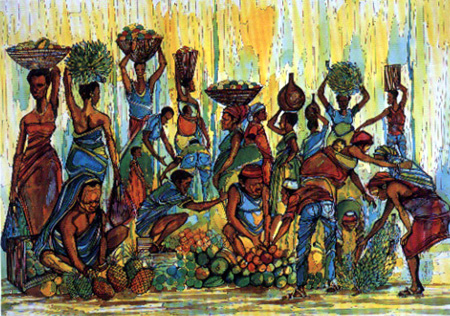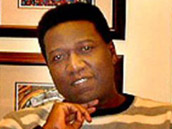| Issue #1 | Archived Issues | ISSN 1916-341X | Feedback | Submissions | Contact |


Don Domanski, Governor-General Literary Award winner, for All our Wonders Unavenged (Brick Books, 2007)
Patrick Iberi: Your works reveal a glaring exploitation of symbolic imagery and themes from your native Uganda and Africa to a large extent. How important is a visual artist’s personal experience as it affects his work?
David Kibuuka: My back ground as a young artist growing up in Uganda was surrounded by existential imageries of my native land. But I do not just exploit the subject themes of my native land; I have added other facets to it as I sail on a cultural journey in fine art. Experience is very important to any artist as it helps shape and moulds your growth as an art professional.
PI: You are referenced in the same breath as your late older brother Henry Lumu, how crucial was his influence on your work?
DK: My late brother was in a class of his own. I was very young when Henry was blazing the Kampala art scene with his work, and by the time I was old enough to understand how good he was, I was hypnotized by his amazing artistry. Yes, without any doubt, Henry influenced me very much towards drawing, painting, plus the modern batik art technique. He opened the door for me to walk through and more importantly, he encouraged me to learn. Henry was the one who made the breakthrough from the traditional batik to the modern batik and I was very lucky to have been there to learn that style of visual expression. Today I try to continue his legacy in teaching the same art technique.
PI: You have been able to infuse Modern fine art technique in your work by drawing from your formal education in computer animation and graphics. What was the impact of this on your work?
DK: The impact has been amazing and it is still ongoing as the whole art industry is being reprogrammed by computer graphics and other packaging methods in cyber space. We are the first generation of African artists that are able to sell our work via the Internet (e-commerce). That change has made it possible to use other computer graphics application like Giclées, which is digital printing direct on canvas or the client can download paid images off our websites. This has impacted the way we sell and publish our work on demand in cyber space.
PI: Your approach to the stereotypical idea of African artists as mere craftsmen/women of motifs, figurines and masks by certain Western art critics is not one of conformity. This is expressed by your experimentation of batik art. What in your own words is the borderline between African art and that of the rest of the world, if there is any?
DK: Art is universal, however it is not uncommon for any artist to cross over and infuse his own experience with prevailing trends. That is my opinion about that question.
PI: How vital is colour in your work?
DK: In the world we live in, colour is very vital in any art work. I love colour and try to experiment with it as much as I can to give my work the feeling of warmth, depth and movement.
PI: You are seen in many circles as a beneficiary of a modern African art movement with emphasis on mixed media, acrylic, oil, water colours and pencil. Which is your favourite means of expression?
DK: Pencil is my favourite media as it is one medium that gives me the key to learn more about any other art subject before introducing colour. Pencil is like a violin to me, I can always tune my skills in drawing.
PI: As a visual artist, what do you look out for in a finished piece of artwork?
DK: I am always on the look out for the use of colours, composition, appropriateness, balance and the way the artist uses space and if it is just a drawing (pencil), I would look out for the flow of the pencil lines or construction of the composition from the beginning.
PI: Your workshops on batik art showcase a modified fine art technique that is broad in depth and rich in colours. What has been the response so far?
DK: The response so far has been amazing. Youth, adults, seniors are enjoying and experimenting with the new-found medium. They are able to either proceed towards fine art details that match mediums like acrylic, watercolour or they can proceed towards textile design or even work on fabric using wax and dyes as this also has wonderful therapeutic values.
PI: What other project(s) are you working on?
DK: I am working on my coffee table book of my art work. I have left this unfinished since I left Uganda in 1977.
PI: What would you consider as your legacy in world of art filled with a variety of gifted illustrators?
DK: I would like to think that it will be a desirable one. But I will leave that for history to judge.
PI: Thanks for your time David
DK: It’s been a great pleasure.
You can view any of the pieces of artwork in this gallery by clicking on the thumbnails below:

David Kibuuka is Ugandan born but immigrated to Ontario, Canada in 1983 and has grown as an artist by presenting his work to a wider audience over the years.
David’s paintigs are influenced by African traditional art and to an extent, contemporary western art. Through his extraordinary ability and remarkable diversity, he gives us a profound and moving insight to the culture in which he was born into and a blend of the variety acquired through formal art lessons. He is one the founders of 'Modern Batik Art Painting' in East Africa where he introduced "Fragmentation" technique to traditional Batik Art.
Kibuuka has hosted art workshops and exhibited his work in Canada, the US, Africa and the Caribbean. His work rests in the homes of private collectors worldwide. David is a spirited humanitarian and has supported fundraising efforts by Unicef though his work. Please visit www.kibuuka.com for more of his paintings.
July 02, 2008
George Elliot Clarke Receives Order of Canada Appointment
June 03, 2008
Gasperau Press Titles Displayed in Alcuin Awards Exhibits
July 04, 2008
New Releases From Gaspereau Press